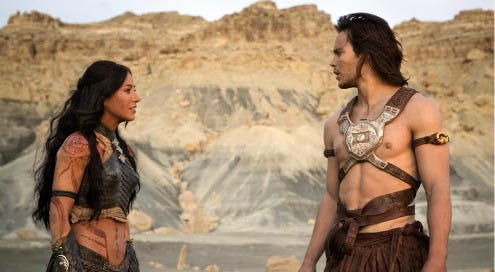John Carter

Watching "John Carter" is literally an overwhelming experience. There were times when I honestly had little idea what the heck was going on. There's such a dizzying array of names, tribes and mythologies to keep up with, all wrapped in a dense thicket of science-fiction jargon and technological doohickeys.
And yet the one thing I was certain of was that I had a great deal of fun watching it. This mega-expensive movie ($250 million by some accounts) is an epic in every sense of the word, an action-packed thrill ride that for sheer audacity is the biggest thing to come down the cinematic pike since "Avatar."
Like James Cameron's film, "John Carter" also features bouts of unintended silliness, and relies more on computer-generated images than big-name stars -- or, indeed, actors you've probably even heard of.
Friends tell me Taylor Kitsch was a big deal on the TV show "Friday Night Lights," playing a high-schooler. (He appears to be at an age where you start looking for gray hairs instead of popping pimples, but that's about par for the course in Hollywood.)
He does have a solid presence as the title character, a dour Civil War veteran accidentally zapped from 1881 to the surface of Mars. His John Carter is a tragic figure and reluctant hero, and Kitsch gives him notes of unspoken regret and layers of complexity not found anywhere in the script. Though he does fall back on that unfortunate action hero trope of speaking most of his dialogue in a growl of strangled urgency.
Director Andrew Stanton is the second Pixar animation director to peel away to live-action filmmaking. I can't say I thought his grasp of real-world kinetics was quite as sharp as Brad Bird's with "Mission: Impossible Ghost Recon," but the movie's many action scenes have an undeniable cartoony zip to them.
The Martian world -- based on a story by Edgar Rice Burroughs, best known for "Tarzan" -- is a sun-drenched cocktail of old and new technology. The human-like inhabitants fly through the air on solar-powered ships and have energy weapons, but for some reason favor armor and swords for really putting it to their enemies.
Everyone has neon-colored tattoos, even on their overly bronzed faces, shows lots of skin and is really buff. It's like Jersey Shore in Space. By comparison, the pasty Carter looks like he was locked in a fridge for five years.
The people of Mars (they call it Barsoom) have been locked in a 1,000-year war between the two major city-states, Zodanga and Helium. Carter gets caught in the middle of the conflict, falling in with Dejah Thoris (Lynn Collins), a Helium princess.
He also becomes a friend/slave to Tars Tarkas (voice by Willem Dafoe), the chieftain of a race of green four-armed nomads called Tharks who populate the desolate areas outside the cities. Sola (Samantha Morton), a Thark outcast, becomes Carter's companion and protector. A toothsome slug-like creature who zips around faster than the Road Runner becomes his loyal hound.
Due to Earth's heavier atmosphere, Carter finds he has amazing powers on Mars, chiefly the ability to leap hundreds of feet in a single bound. One would think his upper-body strength would be equally Superman-like, yet Tars Tarkas (and several others) smack him around like a chihuahua.
The plot (screenplay by Stanton, Mark Andrews and Michael Chabon) is a muddle of different elements of Burroughs' Mars stories, plus some of their own made-up stuff. It has something to do with mysterious advisors called Therns (Mark Strong is their leader) who manipulate the red planet's geopolitics, giving a fantastic blue energy force called The 9th Ray to the Zodangan general (Dominic West).
"John Carter" will hardly be confused with great filmmaking; nothing about it is destined to linger long in the mind or the soul. But for two-hours plus, this Mars is certainly an amusing place to visit.
4 Yaps



